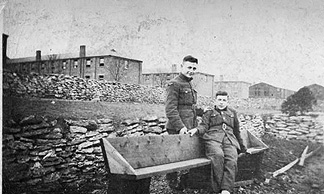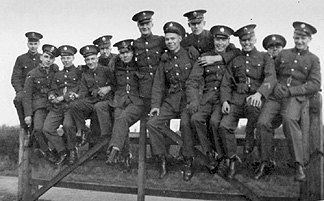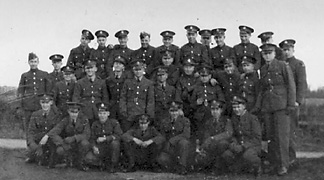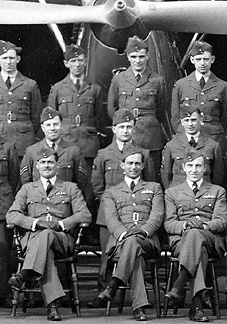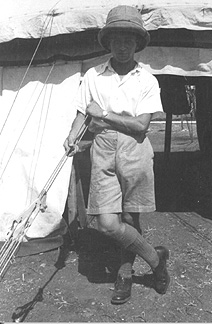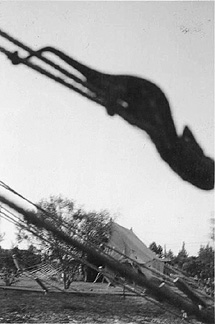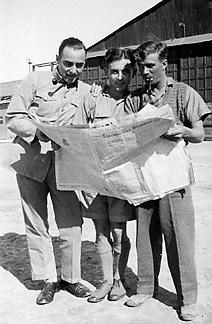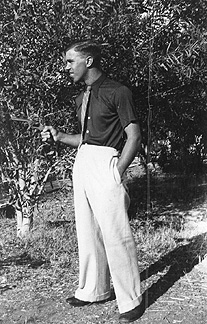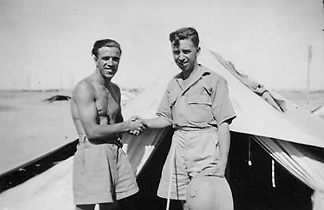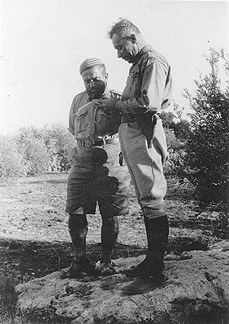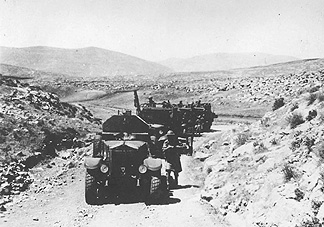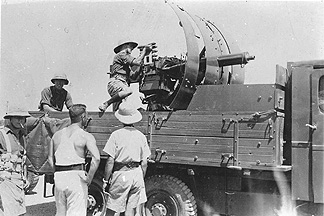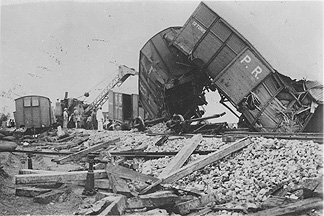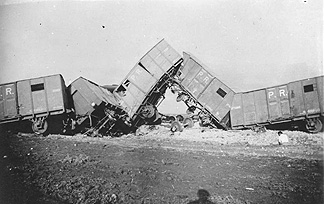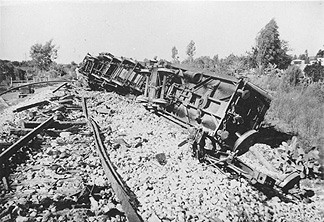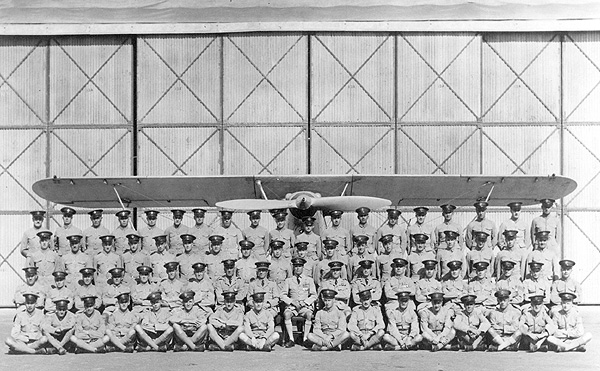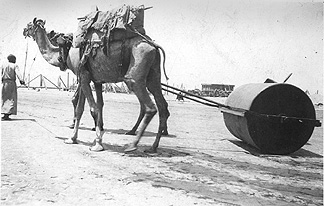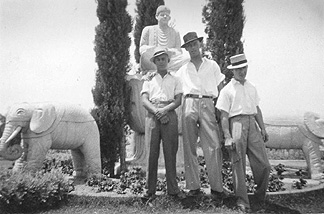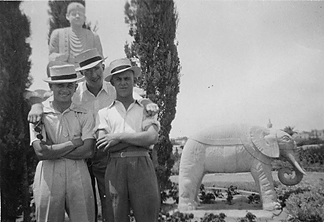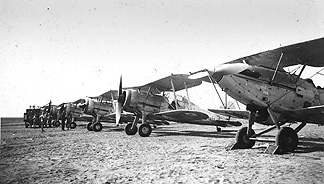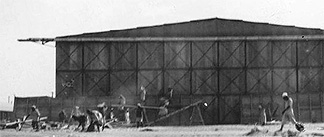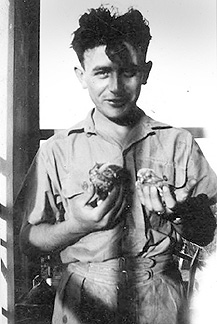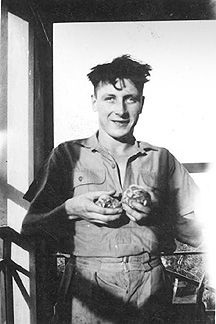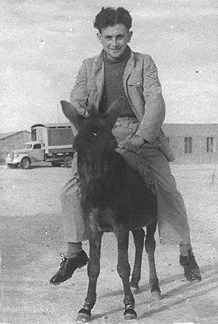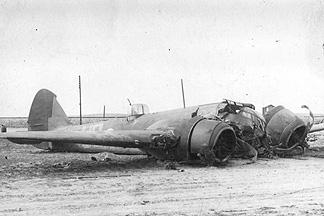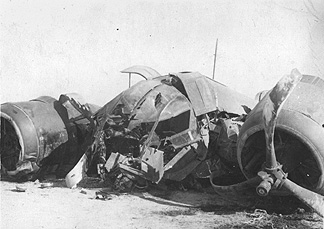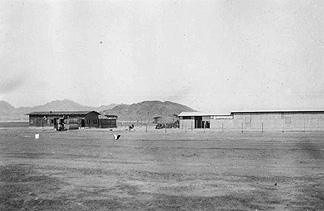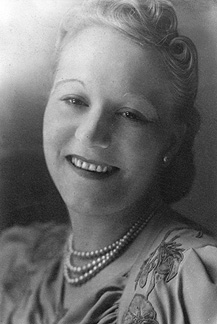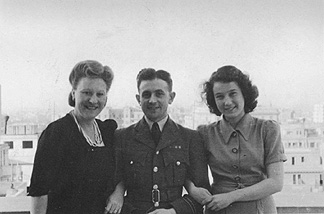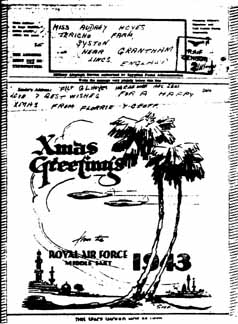 |
 |
|||||||||||||||||||||||||||||||||||||||||||||||||||
|
Corporal Geoffrey L Hoyes 567591 RAF (Flight Lieutenant 48858 RAF) 1918—2003 Married in 1915, it was in the spring of 1918 that Robert Hoyes and his wife had a baby son, Geoffrey Loughton Hoyes, at Claypole, near Newark in Nottinghamshire. By the mid-1930s, the family was living less than 10 miles away at Syston, about five miles north of Grantham in Lincolnshire. RAF Grantham, a station soon to become very familiar to early 211 Squadron members, was only a mile or so from the town.
In the Service Dress of an RAF officer, with the usual fabric belt, gilt buckle and buttons, he wears the ribbons of the General Service Medal and the Africa Star. The July to September detachments to Ramleh and Semakh in 1938 had entitled a number of the 211s (LAC Geoff Grierson, AC William Wright, P/O WH (Bill) Edwards for example) to the GSM (Palestine Clasp), the medal having been instituted for just such smaller campaigns short of all-out war. Geoff Hoyes’ GSM was authorised in 1939 (AMO A539/39) and his Africa Star in 1944. His officer’s uniform and ribbons together point to a date sometime from early 1944 onwards. The medals themselves had to wait until after the war. Lincolnshire and Cranwell By his 18th birthday, GL Hoyes had nearly 18 months training in RAF blue under his belt. By one of the arcana of RAF procedures, that day, 17 May 1936, was duly recorded as the formal start of his 12 year RAF engagement to end in May 1948. In January 1938, course passed, he was formally remustered as WOp/Mech and posted as Aircraftman 1st Class to E&WS RAF Cranwell, where he had qualified with repeated VGs (Very Good) under Character.
Geoff Hoyes as a young apprentice, standing on the left, wearing the early high-neck tunic. The fellowship of those days is evident in the casual group photos of the time. During their last year of training, lads of several entries found themselves thrown together in barracks under quarantine isolation, as a result of a measles outbreak (a rather more serious virus then than today, with childhood immunisation programmes over twenty years in the future). Frank Rosam, of the same intake as Geoffrey, recalled the story in correspondence with John Hoyes after his father’s death in 2003: “As we recovered we couldn't mix with the unaffected so normal instruction was suspended & one of the diversions invented for us was a so-called route march. As you can imagine it turned into something of an outing, complete with impromptu mouth-organ band [...] it was a strange life we led as Aircraft Apprentices and not always an easy one, but I have never met anyone who regretted it.”
Among the 13 lads present are Peter Kay, Phil Pinder, Norman Lee, Dickie Dickens, John Bushell, E Fisher, Bert Pells, George Quincy, P Green, Frank Rosam, Geoffrey Hoyes and J Dawes, all from the 31st entry of apprentices. Here one or two of the lads are smoking: their shilling a day pay stretched far enough for the odd fag, when permitted. Geoff Hoyes is probably second from the right, rear. Third from the right, seated, may be Frank Rosam, with what may be the Apprentice equivalent of a Good Conduct stripe on the left sleeve.
It may be Geoff Hoyes in the front row, squatting, 4th from the left. Both these photographs were taken with Frank Rosam’s camera and of this one he remarked: “More boys in a collar-and-tie uniform—this only came into service in 1937 so it distinguishes them as a very recent entry about two years our junior ( although survivors would all be in their eighties now!). The same characters of our entry appear again with the exception of myself which means that I took the photograph. The two men wearing "caps field-service" are drill/PT NCOs who were supposed to be in charge of us.” To 211 Squadron
Middle row, centre, immediately beneath the Hind propeller boss: AC1 GL Hoyes, WOp badge on his upper sleeve, flanked by a Corporal (to his right) and another WOp (to his left). At the start of April, after a busy period preparing for the move, they were all sent on leave until the 24th of the month. In the early dawn of Saturday 30 April they boarded the train at Grantham for Southampton. There, in the mid-afternoon, the men of No 211 (Bomber) Squadron, No 80 (Fighter) Squadron and No 113 (Bomber) Squadron embarked aboard HMT Lancashire bound for Egypt, as shown in Geoff Grierson’s photographs. Built by Harland & Wolff and a veteran of World War I, at 9,500 tons and capable of 15 knots Lancashire saw almost 50 years service, much of it as a military transport. She was finally scrapped in 1956. In the Middle East Over the coming weeks, they worked up with tours of the desert Landing Grounds, air firing exercises, AA co-operation and fighter affiliation. It was a time of high tension both internationally and in the Middle East. On 14 July the Squadron was put at 36hr readiness for a large scale detachment to Palestine, leaving only ‘C’ Flight at Helwan. In the event, the move was by air over the 2 days 18 and 19 July. Palestine 1938 In support of the Trans-Jordan Frontier Force and the Palestine Police, British forces included a small RAF contingent: 6 Squadron (who bore the brunt of the RAF casualties) and 2 Armoured Car Coy. As the situation worsened during 1938, these RAF units were progressively reinforced with detachments firstly of 80 Squadron (Gladiators), then by 211 Squadron (Hinds), and lastly by 33 Squadron (Gladiators) in place of the 80 Squadron detachment. 14 Squadron and 208 Squadron also rendered assistance. At Ramleh and Semakh As well as the usual formal and informal Squadron-use shots, also seen in the collections of the unknown Airman, Grierson and Wingrove for example, Geoff took quite a lot of photographs himself and kept a number of other prints. Several of the shots, most likely his own, suggest that he may have been a touch impatient in his eagerness to grab a photo opportunity, with the tilted horizon or blurred focus that a hasty jab at the shutter-release could bring. These I have silently tidied up. Some number of prints are captioned (sometimes post-war), as indicated. He had a good eye for a subject, resulting in a collection that captures moments of drama as well as the every-day, while reflecting his own generally cheerful outlook.
Geoff’s own caption for this shot, printed on a photographic post-card blank. In Palestine they made much use of radio, in responding to calls for assistance from ground troops under the XX routine. In the end they fitted all the aircraft with radio, and had to post in a number of additional Wireless operators with no flying or air-gunnery experience.
Possibly the radio tent again, from the entrances. Print processed in Tel Aviv. The Squadron record is silent on periods of stand-down, but the city was less than 15 miles from Ramleh camp.
An artistic presentation of the work-a-day scene during the Palestine detachment—the print again processed by a Tel Aviv shop. The camp at Ramleh was in an orchard setting, with tents for both men and working Sections among the assorted permanent buildings. Here, the diagonal forms of the guys have caught Geoff’s eye for a pretty fair composition, but still his haste to press the shutter shows up, in slight blurring of the background.
Ramleh was in use as a developed station by the RFC and AFC as early as 1917. While the doors of the building in the background offer a potentially serious clue to place and date, no clear match has turned up yet. However, the general form seems to be that of the Hinaidi-type aircraft shed. Originally adopted by the RAF as a low-cost unit for overseas use as early as 1927—at Heliopolis, for example—there is at least one example surviving in the UK today (if with different doors). In this shot, the three mates are reading the Lincolnshire Standard, which suggests an early date in 211 Squadron’s Middle East movements (as does the high-collar jacket of the old-style uniform worn by the man on the left). Geoff Hoyes stands in the middle.The man on the right, out of uniform, seems to be Harry Leedell, but may possibly be his brother WT “Tommy” Leedell. The two brothers both served in the Middle East, Tommy certainly in the RAF. Though one of Geoff’s uncaptioned shots, very probably Palestine in late 1938 and probably Ramleh.
Although Geoff’s own notes suggested that Leedell had been killed in action in September 1942 and had been highly decorated, it was for a time difficult to find any firm trace of him. He did not seem to appear in the Squadron record, nor as a casualty in the CWGC Honour Roll under any reasonable English or European variation of surname at any date to 1945. As an airman, his lack of appearance in the London Gazette or the Air Force List was to be expected, unless either decorated or commissioned. The first hint of more detail came in July 2008 as the Fryatt family gathered in Queensland to mark the passing of Jim, late 211 Squadron armourer of the Desert and Greece. Visiting from the UK, son Roger brought some more of their father’s mementoes to add to the collection held by Adrian his brother. Among these little gems was another photographic copy of the Squadron’s Menidi Christmas 1940 menu, signed on the back as ever, among them some now very familiar hands: Swede Revett, Bill Petitt, Duke Delaney, Squadron Adjutant Bright, and Buckshot Barnes, Squadron MT Officer. And one of remarkable significance to this part of the story: the signature of H Leedell, clear and firm, embellished with some brief Morse. Encouraged by clear evidence of Harry still with the Squadron in Greece in late 1940, further on-line searching found the current Leedell family, still interested in history and the past.
Keith Leedell kindly sent this photograph of his late father Tommy (in desert gear including ST, right) and late uncle Harry, shirtless and casual on the left. These details hint at a date up to about 1940. Clearly the tent-lines in a Middle East camp somewhere. Both posted to the Middle East and RAF service, they met up somewhat to their surprise “at a Mess station in the middle of nowhere”. William Thomas (Tommy) Leedell was an airframe fitter in the Middle East and Sudan. Harry apparently later transferred to the Army, perhaps as a signaller. Both men survived the war.
Leggings and head-gear indicating local troops, perhaps of the TJFF, while the background is similar to Ramleh camp conditions. In later years, Geoff added “1938” in biro on the rear.
An identical print lies in Geoff Grierson’s original albums, uncaptioned, between a section on the Ain Karim incident and a sequence of shots “on the road to Jerusalem” (which was less than 40 miles from Ramleh). Geoff’s own caption would place the shot about 30 miles beyond Jerusalem. Whichever it was, here the apparently peaceful Palestine Hills give no hint of the danger from the armed insurgents of the time.
A patrol in the field, armed to the teeth. In addition to the Rolls Royce armoured car of 2 ACC, at least two of the open trucks mount Lewis machine-guns. All the visible personnel, mounted or dismounted, are wearing their steel helmets.
A unique image of the Vickers 40mm quick-firing 2-pounder gun, here mounted as a mobile hill-piece. The gun-crew position is very exposed, with only the lightest of shielding. Against just the slightest resistance (by rifle fire, for example) it would take real guts to man this piece in the field. The truck cab appears to be sans any protection at first glance, but the side window is fully meshed against unwanted intrusion. This is a very fine shot indeed. Serious business, although here the men are more casually alert, one with neither hat nor shirt and certainly no-one with tin hat. The seated figure in the truck-tray looks searchingly into the distance. The man on the left is smoking, but in full web with canvas-holstered pistol. He looks sharply at the camera. The hatted figure standing back to camera, centre, may also be wearing a side-arm. Late in World War I, Vickers had developed two guns of very useful calibre from Maxim origins. Of the same neat water-cooled quick-firing or pom-pom design were the 37mm unit, a 1-pounder, and this 40mm 2-pounder model. A number of these heavier guns found their way to Mesopotamia. They were versatile enough to be mounted on railway wagons in the Great War and later, as here, on a 3-tonner. Although at this comparatively heavy calibre the belt-feed was a weakness (whether in original fabric form or in the later metal-link version), the Vickers 2-pounder was a very useful weapon and remained in service until 1944 in this form. In the Royal Navy, the gun was the basis of the four-barrel 40mm multiple pom-pom as ship-board AA armament.
Caption: GLH. This graphic sequence shows what they were up against in Palestine in 1938. The airport and its station were some three miles North of the township.
“During the night of the 25th-26th [September], the railway track from Rafa to Lydda was destroyed over a distance of 12 kilometres with the result that rail traffic to Egypt was suspended for eight days.” While the action in Palestine was hot throughout September, as the month drew to a close, in Germany Herr Hitler’s designs on the Sudetenland brought the Continental powers to the very brink of war. On 28 September, the 211 Squadron detachment was warned to expect to return to Egypt at short notice, “in view of the European situation”. By air to Egypt Re-united with ‘C’ Flight at Helwan, a furious day or so ensued. On arrival that same day, an Advance Party was sent forward at once to start preparing El Dabaa, 200 miles out in the Western Desert and their war station in case the balloon did go up. Meanwhile at Helwan, the Fitters laboured mightily to get as many aircraft as possible up to full serviceability, also bringing forward 120hr inspections on any machine with less than 20hrs remaining to that service. When, in the early hours of 30 September, Chamberlain, Mussolini, Hitler and the French Prime Minister Daladier signed the Munich Agreement, immediate war was averted—at the price of dismembering Czechoslovakia. Helwan 1938 Despite the recent tension, the rest of the month passed with a series of more or less gala events: the mass flypast, the combined RAF/REAF review, presentation of the Squadron badge (recounted on Allan Farrington’s page), and a top-brass Station visit. All events no doubt backed up behind the scenes by much furious toil in hangar and barracks, to bull-up and blanco everything in sight. These efforts were capped off for Geoffrey Hoyes on 31 October. In the new Group I trade title Wireless Electrical Mechanic (WEM), his proficiency was rated superior, a fillip beyond his accrual of another blemish-free VG in the Character column. Reclassification to Leading Aircraftman followed the next day. On 1 December he formally remustered as WEM, the title implying more technical application beyond signalling (the trade was later to include radar equipment in its work). A heady month for the ex-Cranwell apprentice at age 20.
GL Hoyes centre, rear rank, beneath the Hind prop-boss. This magnificent print adds one more to the set of formal Squadron photographs taken on the hangar apron at Helwan in late 1938 after the return of ‘A’, ‘B’ and the HQ Flight from Palestine. Like Grierson, Geoff also kept a copy of the Squadron shot, where he appeared in the same position, centre rear. The Squadron back together after the Palestine move, in No 1 tropical kit with medals worn for these formal group photographs, taken perhaps on 18 or 19 October.
Geoff’s caption note continued “Rolling tarmac in front of hangars Helwan 1938”. While steel hangars were being extended there from 1936, the Station was still being built up when 211 Squadron arrived in 1938. An identical print lies in Geoff Grierson’s albums.
These fellows look pretty sharp in their town gear. By no means a tall man at 5’ 1” on entry aged 16, Geoff Hoyes is readily recognised in most group shots, but here appearances are deceiving. He is not in this shot, but is in the matching shot below.
Geoff Hoyes, left, in the matching shot from the album of Ralph Wingrove—who is not in either group! The man on the right here is on the left in Geoff’s shot, while the fellow in the centre here is on the right. Egypt, with its long history of expatriate communities and extremes of climate and geography, possessed exotic public gardens of some extent in most major cities: Cairo (Al Gazira Gardens); Alexandria (Muntazah Palace Gardens and Rond Gardens); Ismailia (French Gardens) and Port Said (Palm Gardens), all known to off-duty servicemen looking for thrifty relaxation and a change from sand and sun. Here, the lads take some time off in the Japanese Gardens in Helwan, as Wingrove’s album makes clear.
Caption: GL Hoyes. Down The Flights, as they used to say. Here the aircraft are being refuelled for duty from the bowser, one of its triple hoses extended to a waiting Gladiator fourth down the line. A group of airmen in STs attend upon the operation, while two men, perhaps aircrew, lean against the next nearest machine and observe the photographer. In the foreground, a chocked Hawker Hind with external bomb racks under the wings. Almost anonymous, its serial ends in 3 or perhaps 33: possibly a 211 Squadron machine. The second aircraft, nearest of the Gladiators, is a Mark I machine of a batch delivered to the RAF between December 1937 and January 1938, all of which were destined for 33 Squadron service. This aircraft, L7613, was damaged beyond repair on 1 March 1939. Here its cockpit side hatch is open and there are no covers, chocks or tethers evident anywhere in shot: all suggestive of an imminent start to the day’s flying. In the Middle East from 1935, 33 Squadron occupied most of the familiar pre-war bases at one point or another, taking on their new Gladiators from February 1938 when they were nominally at Ismailia. This shot could date from early 1938 or perhaps early 1939.
Clearly the main Helwan hangar. A similar shot of the local labour force working on the apron lies among Geoff Grierson’s albums.
The mobile Squadron on the road. The Fordson 3-tonners in RAF blue suggest one of the Squadron’s peace-time movements, possibly to or from its Western Desert war-station. A related image in the collection of Ralph Wingrove also has the men in tropicals (khaki drill)—a good hint that this may be the April 1939 El Dabaa party. The movement to Ismailia in late January 1939 had the men in working blues, as seen in the collections of both Wingrove and my late father. These were carefully organised affairs and some effort was put into rehearsing the preparations. As a rule, the moves were staged in three parts. That in January 1939 to Ismailia saw the advance (road) party depart on 3 January, with the main body arriving on 21 January and the Rear Party completing the move on 27 January. And for that move, to a permanent RAF station, they wore their blues for the dusty journey!
By the end of May 1939, they were established at Ismailia with a full complement of Blenheims. Despite the by-now expected shortages of equipment for the aircraft, serviceability was at a sufficient peak to permit servicing of Blenheim Delivery Flight (BDF) machines freshly arrived from the UK. By the end of the month, the Greyhounds had made their own contribution, air-ferrying 9 aircraft to Aden, AC Wingrove enjoying one such "jolly". Up The Blue: El Daba 1939 to 1940 This time it was to be a damned long stay up The Blue. In the afternoon of 3 September, the Squadron signallers took the formal message. War at last, but with Germany only. By October Poland had fallen, but in Western Europe (and the Middle East), the Winter and Spring were to be the period of the Phoney War. Absence of immediate hostilities apart, desert life in war-time had many irritations and few compensations. At Daba there was access to the beach, though some distance away. At cliff-top Quotaifiyah, the sea was closer, making for more pleasant camp conditions, though beach access was a touch more difficult. Geoff Hoyes and Mike Sainsbury both enjoyed the fishing and P/O Farrington took to the surf, but the late Jim Fryatt was very nearly drowned there. At some point, for reasons not recorded, the beach was made out of bounds to airmen, a restriction that long rankled with Geoff. Winter came, with the mild days and cool nights of the Desert. At the end of the year, with 21 months service in 211 Squadron, his level of trade-craft and ability to exercise it with authority were accorded due recognition. He was made Corporal with effect from 1 November, having notched up another VG in the Character column, another Superior in Proficiency, and the other necessary recommendations for promotion. The Squadron Operations Record Book duly recorded the promotions of Geoff Hoyes and 12 other LACs, among them Harry Callison, armourer (later Sgt Armourer at Wadi Gazouza in 1941).
Corporal’s tapes already sewn on. Possibly El Dabaa, possibly late 1939 or perhaps 1940. There were buildings not unlike this at the railway station. The truck, left rear, has the familiar curved double roof of vehicles used by the Photo Section, for example, and is wearing desert paint: no more RAF blue. Other than that, the scene has more a look of peace than war. This may be a winter shot, from the roll-neck. As 1939 drew to a close, Blenheim Is continued to arrive in the Middle East by the BDF system. Attached to the Squadron after such flights were F/O George Doudney (on 5 October) and P/O LS “Duke” Delaney (22 November), their postings being made permanent on 28 December. As the desert days wore on, the 211s trained often, with navigation and bombing exercises. Sometimes the results could have been better.
L1486 was destroyed in P/O CPR “Pete” Collier’s night-flying accident on Wednesday 13 March 1940. Despite the state of the cockpit, he and LAC Thomas, up for air experience, both survived. Here the turret is up, showing clearly the characteristic Vickers K barrel.
Photographs of the accident were held by a number of Squadron lads: Cooper, Grierson, Sainsbury, Sharratt and Wingrove.
The tent to the left rear suggests the Desert, possibly at El Daba. Possibly the rear of an open truck, far left. Geoff kept two other photographs with the dog (with a football). This crisp, carefully composed shot has the look of an official photographer’s work. Geoff was often brimful of good cheer when caught by the lens of a camera. The Greyhounds go to war Whatever war plans the Regia Aeronautica in Libya may have had, they were not for an immediate strike. In that, with plans made and Squadrons at readiness, Longmore and Collishaw trumped them. In the early morning of 11 June, 45 Squadron were over El Adem airfield at dawn, bombing, while at first light 211 Squadron carried out a series of armed reconnaissance sorties. The Blenheims found the RA “at home” but unprepared, without apparent evidence of dispersal of either aircraft or fuel. At this point, the Squadron Operations Record Book is incomplete for some reason. There are but two pages in the diary for June, one of end-of-month Section summary remarks from Cypher, Photography, Mechanical Transport, Armoury and so on. The other page, with some daily entries with details of operational sorties, breaks off at 3 June. The Monthly (Form 540) pages follow on in correct numbered sequence but resume on 1 July. The Daily Sheets (the detailed sortie reports, Form 541) only start at 10 July. True, there are a number of interesting Appendices included in the run of ORB sheets (in AIR 27/1302) and in the Appendix set proper (AIR 27/1304), but none of them are for June. Thus the usual sequence of detailed operations records is entirely absent for the period from 4 June to 10 July. These seem to have been lost at some point beyond RAF ME, perhaps between Central Records and the National Archives, as it is clear from the post-war AHB Narrative with its copious marginal notes that the missing ORB pages did once exist. Still, there are traces of the Greyhounds work, in Longmore’s unpublished first Despatch for example, as well as the surviving Flying Log Books of 211 Squadron men, such as then Flight commander Gordon-Finlayson and others. For example, over the 18 days of June, GF flew on 9 operations in all, three of them for reconnaissance, six of them as bombing raids (and adding two more by 10 July). From these varied sources, it is possible to say that 211 Squadron’s Desert War certainly began with those first-light sorties of 11 June, and that between then and 28 June they carried out bombing raids against various targets on at least nine days, among them Tobruk, Capuzzo, El Adem and El Gubbi. The Armoury Section remarks that at least four were mass raids at what was then full-strength (nine aircraft), while the details of armament expended are certainly the equivalent of 36 full-load sorties (ie 4x9aircraft carrying 1,000lbs of mixed ordnance). Of these, it has been possible to construct a partial summary of 18 of the Squadron’s June sorties, from the available Log Books. Aircrew or groundcrew As early as 21 May, an AMES station had been set up nearby, the Squadron undertaking calibration flights for the operators of 204 Mobile Radio Unit to tune their radar set, at that time a highly secret device. In the radio world it was very advanced equipment, for which Wireless Electrical Mechanics provided the qualified technical staff. At about this time, 211 Squadron also had a "Special Duty Post" of Squadron Signals Section men out on the coast, for which details of duty are scant but perhaps to do with the AMES station: an outpost suitable for a steady Cpl WEM. In the air, the Squadron operations workload was heavy indeed from 11 June, for pilots, observers and gunners. In these early days, bomber crews were still very much scratch arrangements, the WOp/AGs in particular as likely as not trained on the Squadron and if no longer part-time, still sitting in the turret as ACs, LACs and even Corporals. It was during this early period that Geoffrey Hoyes later recalled flying on operations for some weeks, with no lesser light than P/O LS “Duke” Delaney as WOp/AG, starting with that 11 June sortie. With no formal ORB account and no Log Book record for either Delaney (lost in Greece) or for Hoyes, it is sadly impossible to reconstruct his operational experience with certainty, though it would have been quite intense. Even doughty GF was hard-put during this period: shot-up on one occasion to forced-land at Sidi Barrani with a dud port engine—then, as leader on a night raid, having to abandon when his navigation lights failed. An interesting insight into this period of the war! At this stage of the Desert war, crews were very often scratch affairs "on the day", the firm partnerships coming rather later on. While the Pilot's Flying Log was the only one to record the complete crew, an Observer or Gunner was to enter the pilot's name in his Log, but not that of the other member. Other Squadron records show that in the Desert, Sgt Observer Bill Stack often flew in the right-hand seat to the Duke. So in his Flying Log Book, Stack recorded two of the earliest operational sorties with Delaney, that first one on 11 June 1940 and another the next day. These are consistent with Geoff Hoyes’ later recall and also hint at the early rate of work. By Geoff’s own account, his operational period ended just as WOp/AG Sgt George Sewell came to crew with Delaney, an event not remarked in the extant ORB sheets. With Sgt Smith (pilot) and Sgt Steele (observer), Sewell failed to return from a night raid on El Adem on 22 July in Blenheim L6661, his funeral noted on Wingrove’s page. While Delaney flew on raids from 10 July onwards, as did Sewell, if the ORB is correct (which it broadly seems to be at this date, consistent with GF’s log) Geoff Hoyes does not appear as crew with Delaney in any sortie listed between 10 July and the departure of the Squadron on 7 November for Ismailia, to prepare to deploy to Greece. It seems most likely then that Geoff Hoyes’ operational sorties were all in those stirring four weeks from 11 June 1940 onwards, where the Squadron record is unfortunately lacking. While the Blenheim squadrons were very active in the first weeks of the air campaign, Longmore was acutely aware of how thinly his force was spread while awaiting the expected Italian advance. During July and August, operations continued but with some eye to conserving forces. The long expected Italian advance into Egypt began on 13 September 1940. In less than a week, the offensive had advanced some 50 miles East of the Libyan border to over-run Sidi Barrani by 18 September. On 20 September the Italians were consolidating their positions, having also overrun the DLGs some 15 miles further on, denying them to the fighter squadrons of 202 Group. This left the forward RAF position some 60 miles further East at Mersah Matruh. On 15 September Collishaw prudently split his HQ once more, leaving a forward command echelon at Maaten Bagush while withdrawing the administrative group to the rear. While RAF operations in the Desert continued, General Wavell made careful preparations for Operation Compass, the Western Desert offensive that opened on 9 December 1940. In the meantime, however, Longmore and Collishaw had other problems to face. On 28 October, Mussolini launched an attack on northern Greece from Albania. Three days later, 30 Squadron with its mixed Blenheim Mark I and Mark IF force went to Greece, followed over the first weeks of November by 80 Squadron (Gladiators), 84 Squadron (Blenheims) and 211 Squadron. In Greece, F/O Duke Delaney and his crew (Sgt Vic Pollard and Sgt Jock McCord) lost their lives in Blenheim I L8536 on the Valona raid of 6 January 1941, from which F/O RD Campbell, Sgt Beharrel and Sgt Appleyard fell PoW after ditching L1487 in the Adriatic. From May 1940 the RAF had given formal recognition to the role of Observers and Wireless Operator/Air Gunners, to be made Sergeant aircrew from the outset. In the Middle East, aircrew arrangements were firming around these requirements from August or September 1940, when formal courses were offered to airmen who had so far been part-time gunners. For example, AC Bill Pattinson of 211 Squadron was one such, who passed out of 4 AG Course at Ismailia about this time. Thus WOp/AG JG Sharratt was made up to Sgt at about this time, also. Time to move on It may have been during the AHQ attachment that, charged with driving a radio truck for the first time, the task put them so far forward as to find the Italians advancing towards them over the next ridge. On another occasion, he later recalled, a visit to a forward observation post to supply new batteries led to brief capture by the Italians: somehow he and a companion escaped to walk back. The AHB Narrative records the difficulty of placing forward air observers too far out from Mersah Matruh around September 1940—it may be from that time that his recall of high adventure relates. According to some accounts, some of the highly trained technical trades were deemed too valuable to serve as aircrew. How that squared with putting such men in highly exposed positions on the ground is another matter. On the other hand, for some airmen, like WOp/AG Grierson, their length of prior service was such that, now aged over 30, they were past the age limit for pilot training. By 23 October 1940 Geoff Hoyes was posted to 102 Maintenance Unit, then at Abu Sueir, 10 miles from Ismailia. Within six weeks he was a Sergeant, his path of technical expertise set by both ability and experience. His time with 211 Squadron was done. In later life, he recalled having charge of a an electrical repair workshop in caves near the Pyramids. Certainly 101 MU (later as 111 MU) operated from the ancient limestone quarries at Tura South of Cairo, as recounted in the post-war RAF history, AP 3236 Works. According to his service record, though, from 10 April 1941 he was attached to 103 Maintenance Unit, at Aboukir near Alexandria. With the move came promotion once more: from 1 May 1941 he was made Flight Sgt and thus, in the words of KR&ACI para 491 “able to take charge of a workshop comprising a number of heterogeneous trades”. Apparently he then returned to 102 MU, before moving South to RAF Station Khartoum. Khartoum and The Sudan
No firm identity for this location or date, although the topography and buildings are strongly reminiscent of those found in The Sudan. There is similar country along the rail route from Port Sudan through the Red Sea Hills to Kassala and Atbara. All remote country, with a long history of British presence from the 19th century. The Italian 1936 intervention in Abyssinia had drawn a large RAF contingent to encamp at Gebeit, a familiar stop for 211s posted to Wadi Gazouza, if tinged with sorrow for the natural death of Sgt Observer JJ (Paddy) Kavanagh DFM there in October 1941. But the hills might be those NW of the two airfields at Khartoum and nearby Gordon’s Tree, or even perhaps the view South of El Geneina, over 700 miles to the West. In Geoff’s later recall, he spent some time at Geneina from July 1941, soon after his arrival at Khartoum. It would difficult to overstate the importance of the outpost at Geneina, however remote. Almost on the border of Chad, from September 1941 it was more or less the half-way point on the demanding Takoradi air-reinforcement route to Egypt as Staging Post El Geneina (later, baldly, No 25 SP). It would be interesting to find out more about the maintenance, signalling and air control tasks needed to marshal traffic on such long air ferry routes. Later in the war, after Geoff’s time in The Sudan, it was also home to No 1567 Met Flight. 203 Group RAF Khartoum had responsibility for a vast and varied theatre. While most steps in war-time were temporary or “war emergency” only, much acting rank also arose, a deal of it unpaid. When he was made acting Warrant Officer at Khartoum on 1 October 1941, he was one of the fortunate—”acting, paid”, his record carefully notes: all proper reward for wide technical experience and the “self-reliance, initiative, and resource” required at this level. By now the ever-longer run of VGs had been matched by a growing string of Exceptional proficiency notations in the Promotion column. The step up to WO thus came with an offer of further advance: recommended for a commission by HQ 203 Group. Less than 3 weeks after putting up his WO badges, he was before the Medical Board at Khartoum, the next necessary step. Here at last we find the explanation for having taken the technical career path: accepted for a commission, his Officer’s service record shows that he was passed fit for Technical Branch, classified A4B by the Medical Board (fit for flying as non-combatant passenger, fit for ground duties). To make aircrew in the General Duties Branch, only A1B (fit for full flying duties and ground duties) would have done. This fate he would have known with 211 Squadron when he sought to re-muster for aircrew training but, for an airman, the medical classification was recorded elsewhere and not on the service record form. In one of the quirks of the Service, some eagle eye now discovered he was past due for his first Good Conduct badge, which was duly awarded at the end of the first week of January 1942. Well, 3d a day extra: at least, for his last fortnight in the ranks. So, on 25 Jan 1942, he was discharged from duty as an airman, to be sworn the next day to his commission as Pilot Officer. He took up duty with Signals at RAF Khartoum that day, 26 January—Australia Day, curiously enough. By March, he was slated as Signals 203 Group HQ. The period in The Sudan seems to have been pretty varied. Geoff later recalled being seconded as Wireless Officer to The Sudan Defence Force at Kufra, far out in the Sahara, in the September 1942 thrust to take Jalo in support of withdrawing LRDG elements from an ill-starred action before El Alamein. His Service Record only sheds faint light on this, perhaps shown by his brief stint from August 1942 with 159 Squadron. They were temporarily based in Palestine from July 1942, mounting raids with their Liberators in North Africa and elsewhere in the Middle East theatre before moving on to India. In October 1942 Geoff was promoted to Flying Officer. It was about then, back in Khartoum at HQ 203 Group again, that he first met Florence Petmezaki (née Gaisford), who had returned to her home there from West Africa with her young daughter Daphne in very difficult circumstances, her Greek non-combatant husband having gone missing somewhere between Lagos, Kano and Geneina, never to be seen again. As Acting Flight Lieutenant from January 1943, he was still at 203 Group HQ in Khartoum when the Axis forces in Africa capitulated on 13 May. It was clear that the tide of war had now begun to turn. Four days later, Geoff made a more personal advance of his own, proposing to Florrie. She accepted. By June he was with RAF Khartoum Signals once more. Around this time Philip Guedalla was visiting the city, writing the Prelude to his Middle East 1940-1942 there. In this optimistic period, a fresh posting came his way, as Signals F/Lt to RAF HQ Middle East, Cairo, from 4 September 1943. A move back to the centre of things appealed to both Geoff and his fiancée.
Cairo
In this warmly cheerful group with Florence and a friend, Geoff is wearing his service-dress uniform, with GSM and Africa Star ribbons. By happy coincidence, the photographer’s casual composition has caught not only the cuff braid that shows Geoff to be Flt Lt, but also Florence’s left hand showing her wedding band. The evident good cheer aside, these clues offer a good hint of a date, some time after their wedding. By now, Florrie knew her “boy in blue” well. He had seen much and got away with it, in Palestine, the Western Desert, The Sudan and the Sahara. With warmth and wisdom perhaps born of war’s misfortune, for their first Christmas together she found him a gift of enduring significance: a copy of Tommy Wisdom’s Wings Over Olympus. With her simple inscription and his terse annotations, that copy remains with the family today.
Geoff wrote home to the family often, either by airmail or airgraph. In this example from 1943, he has found a way to squeeze in a brief message in the address space above the RAF Christmas design, now quite jaunty compared with the wistful 1941 sketch. The transport of microfilmed messages by air dates back to the siege of Paris in 1870—then, by a combination of balloon and carrier pigeon. In World War II, the British GPO adopted the Kodak-based airgraph system. From 1941, the brief airgraph forms were filmed before transport by air, then photographically printed again for delivery. The system did much to improve the flow of letters between British Commonwealth servicemen abroad and their families at home. Personal correspondence to and from hundreds of thousands of men and women on war service overseas was very important for morale, but potentially a very large logistical task. By the airgraph method, a single roll of 16mm film weighing 5oz carried the equivalent of 1600 or 1700 airmail letters weighing 44lbs or so. Costing 3d each, between April 1941 and Jul 1945 over 135 million such messages had been sent. About 12 tons of film, instead of about 1700 tons of letters, by air. England, this England With the liberation of Europe near he was to be repatriated. Posted to the RAF reception depot at No 1 Personnel Despatch Centre of West Kirby near Liverpool on 14 May 1944, for the time being he relinquished his acting F/Lt. Disembarked at Liverpool on 1 June, they sent him home on disembarkation leave for June. The RAF system carried on in the background and by 1 July he was made F/Lt (temporary) and posted through HQ Air Defence of Great Britain to 11 Group West Malling, as Signals supernumerary on 2 July. From there his technical experience grew ever deeper, on the Special Duty List of the Air Ministry Signals Unit from mid September, then through 11 Group HQ Signals to Manston, and in April, as the war drew to a close, at CHQ 11 Group, Portsmouth. So ended Geoff Hoyes’ war. At last he could unwind a little. In April and again in late 1945 he was ill briefly, before a series of short postings with 12 Group West Raynham, 11 Group at legendary Tangmere and the Central Flying Establishment there, ending back at West Raynham in September 1945. Then in January and February 1946 he was ill again, this time so unwell that he was rated A4hBh (Fit for flying duties as non-combatant passenger and for ground duties—Home service only). By the Summer of 1946 he was well enough to be tackling 3 Radar Course for Signals Officers at 27 Group’s 8 Radio School, passing out successfully in September. Completing this potentially testing period may well have given him some pleasure and, if the course-work allowed it, a fine excuse to squire Florrie about the very heart of the Royal Air Force: 8 RS was at RAF Cranwell, where he had last sat on a gate in the tunic of an Aircraft Apprentice, one cold Spring day 9 years before. By the end of the course he was quite well again, regaining his A4B medical classification. Radar and other technical Signals postings followed, back to CFE, to RAF Rudloe Manor (the sensitive underground communications centre near Bath), and finally in March 1947 back to 12 Group HQ. Stand easy... His RAF career had taken him, in almost 13 years service, from Apprentice to Flight Lieutenant, from the green fields and mists of Lincolnshire to the sand and sun of the Desert, from peace to War and back again. All that wireless and radar work stood him in good stead. Joining the British Civil Aviation Authority, Geoff worked on for another 30 years, retiring in May 1978 from his senior position as head of navigation and landing aids at London (Heathrow) Airport. He had just turned 60. Florence passed away on 4 April 2001, Geoff on 12 July 2003. Their son John has kindly gone to very considerable effort in making a rich selection of family photographs and papers available for the drafting of this page. Among the collection are many places and prints familiar from the collections of Geoff Grierson, Ralp Wingrove, the unknown Airman and others, men who would very likely have been of his acquaintance. Sources Air Ministry Air Force List issues 1942 to 1948
www.211squadron.org © D Clark & others 1998—2025 |
|||||||||||||||||||||||||||||||||||||||||||||||||||

